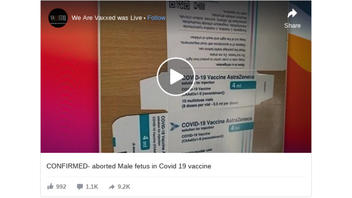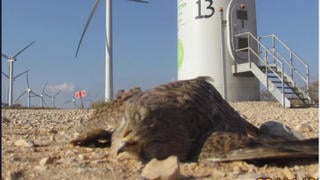
Has it been confirmed that cells from an aborted male fetus are in the COVID-19 vaccine? No, that's not true: AstraZeneca's ChAdOx1 vaccine candidate has been tested using MRC-5 cells, which are replications of lung tissue cells taken from an aborted male fetus in 1966, but there is no evidence that the cells are in the vaccine itself. MRC-5 cells have been used to develop and test many major vaccines over the past five decades. MRC-5 apparently has not been used in the development of Pfizer's BNT162b2, which is currently considered the most likely candidate for early approval in the United States.
The claim that aborted male fetus cells would be in a COVID-19 vaccine appeared in a video (archived here) published by the We Are Vaxxed Facebook page on November 15, 2020, under the title "CONFIRMED- aborted Male fetus in Covid 19 vaccine". It opened with a woman narrator saying:
People, we have a bit of information. I want you to listen. Hear this incredibly well. This is a fact. I want you to share this everywhere. I want you to screengrab it. I want you to copy it. Whatever it takes because they will take this down. This is fact. Share it to your Bible groups or anybody else that doesn't want abortion fetal fragments put into them or their DNA changed. This is a fact. This is the packaging of the AstraZeneca COVID-19 vaccine. Ok. Right in front of you.
This is what the post looked like on Facebook at the time of writing:
(Source: Facebook screenshot taken on Sun Nov 15 23:46:17 2020 UTC)
The claim that MRC-5 cells used in the development of a COVID-19 vaccine means that "abortion fetal fragments" would be in a vaccine is a gross misrepresentation of the facts. The Kennedy Institute of Ethics at Georgetown University explained the history of MRC-5 on a webpage titled Is it true that there are vaccines produced using aborted fetuses?:
Some of the vaccines currently used to prevent diseases such as rubella, measles, rabies, poliomyelitis, hepatitis A, chickenpox or smallpox are produced using tissues from human abortions.
The page explains about MRC-5:
The MRC-5 cells were obtained in 1966 from the lungs of a 14-week male fetus.The initials MRC indicate Medical Research Council, a body from London.
The use of MRC-5 in the development of vaccines is not a new controversy.
An ABC News article titled What Aborted Fetuses Have to Do With Vaccines explained in 2015:
Other common vaccines, including those for chicken pox, hepatitis and rabies, are also propagated in cells originating from legally aborted human fetuses, according to the FDA.
"These abortions, which occurred decades ago, were not undertaken with the intent of producing vaccines," said a spokeswoman for the U.S. Centers Disease Control and Prevention.
The original cells were obtained more than 50 years ago and have been maintained under strict federal guidelines by the American Type Culture Collection, according to Merck.
"These cell lines are now more than three generations removed from their origin, and we have not used any new tissue to produce these vaccines," the company added in its statement.
To say that the vaccines contain a significant amount of human fetal tissue, as some objectors to the vaccines claim, is misleading, stressed Dr. Paul Offit, the director of the vaccine education center at the Children's Hospital of Philadelphia.
"There are perhaps nanograms of DNA fragments still found in the vaccine, perhaps billionths of a gram," he said. "You would find as much if you analyzed the fruits and vegetables you eat."
As the video correctly noted, an article on ResearchSquare.com confirmed that MRC-5 was used by scientists developing AstraZeneca's ChAdOx1. But it was used to analyze the vaccine, not as an ingredient:
Methods: We used direct RNA sequencing to analyse transcript expression from the ChAdOx1 nCoV-19 genome in human MRC-5 and A549 cell lines that are non-permissive for vector replication alongside the replication permissive cell line, HEK293. In addition, we used quantitative proteomics to study over time the proteome and phosphoproteome of A549 and MRC5 cells infected with the ChAdOx1 nCoV-19 vaccine candidate.
Results: The expected SARS-CoV-2 S coding transcript dominated in all cell lines. We also detected rare S transcripts with aberrant splice patterns or polyadenylation site usage. Adenovirus vector transcripts were almost absent in MRC-5 cells but in A549 cells there was a broader repertoire of adenoviral gene expression at very low levels. Proteomically, in addition to S glycoprotein, we detected multiple adenovirus proteins in A549 cells compared to just one in MRC5 cells.
There is no evidence that "fragments" of MRC-5 will be in that vaccine.
The BNT162b2 vaccine candidate developed by Pfizer and Biontech, which the companies report may have a 90% effectiveness rate, did not involve the use of MRC-5 cells.
Lead Stories previously debunk the false claim that the presence of MRC-5 in vaccines would allow a citizen to legally decline a vaccine for religious reasons:
Fact Check: Viral Meme Advising How To 'Legally Decline' A Vaccine Is NOT Accurate
















